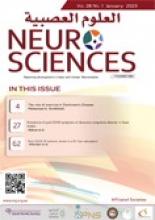Article Figures & Data
Tables
- Headache occurring on ≥15 days/month in a patient with pre-existing headache disorder
- Regular overuse for >3 months of one or more drugs that can be taken for acute and/or symptomatic treatment of headache*
- Not better accounted for by another International Classification of Headache Disorders (ICHD-3) diagnosis
↵* Regular intake of simple analgesics for ≥ 15 days /month or ergotamine, opioids, and triptans for ≥10 days/month
- Table 2
- Comparison between all the diagnostic criteria of medication overuse headache by the International Classification of Headache Disorders (ICHD) 1, 2, and 3.
ICHD-1 ICHD-2 ICHD-3 A- Occurs after daily dose of a substance for ≥ 3 months.
B- A certain required minimum dose should be indicated.
C- Headache is chronic (≥ 15 days/month).
D- Headache disappears within 1 month after withdrawal of the substance.
A- Headache present on ≥ 15 days/month fulfilling criteria C and D.
B- Regular overuse for > 3 months of one or more drugs that can be taken for acute and/or symptomatic treatment of headache.
C- Headache has developed or markedly worsened during medication overuse.
D- Headache resolves or reverts to its previous pattern within 2 months after discontinuation of overused medication.
A- Headache occurring on ≥ 15 days/month in a patient with pre-existing headache disorder
B- Regular overuse for > 3 months of one or more drugs that can be taken for acute and/or symptomatic treatment of headache*
C- Not better accounted for by another International Classification of Headache Disorders (ICHD-3) diagnosis.
↵* Regular intake of simple analgesics for ≥ 15 days /month OR ergotamine, opioids, and triptans for ≥ 10 days/month.
A- Education of the general population and healthcare providers with general practitioners intervention
B- Management strategies for MOH:
C- Abrupt withdrawal: treatment of choice for triptans, ergots, simple and combination analgesics, and NSAIDs
D- Gradual withdrawal: best for the overuse of opioids, barbiturates, and benzodiazepines
E- Outpatient management is recommended for committed, motivated patients, taking non-opioid and non-barbiturate medications, and who do not have any comorbidities. Inpatient care management is usually considered because of failed outpatient management, overuse of barbiturates, opioids or benzodiazepines, or those with medical or psychiatric comorbidities, and with severe withdrawal symptoms such as vomiting
F- Valproate, nabilone, onabotulinumtoxin A, topiramate, and amitriptyline are used as prophylactic management






